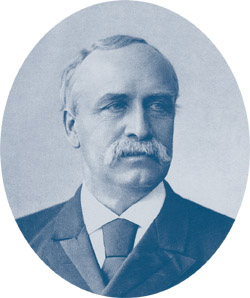 THE UNIVERSITY OF WASHINGTON ALUMNI MAGAZINE
THE UNIVERSITY OF WASHINGTON ALUMNI MAGAZINE
 THE UNIVERSITY OF WASHINGTON ALUMNI MAGAZINE
THE UNIVERSITY OF WASHINGTON ALUMNI MAGAZINE
|
Our Back PagesThe Donor Who Saved the 'U'The UW was facing a crisis. Without funds from the state Legislature, the school was forced to cut programs and faculty. Tuition was one solution but an extremely unpopular one. The strapped president was left with nowhere to turn. His only hope was a donation from a charitable citizen. In the late 19th century, times were hard. The fledgling University of Washington had already closed four times and was struggling to keep afloat. When Alexander J. Anderson was appointed University President in 1877, the consensus in Olympia was that this was the last chance. If the school closed again, chances were it would never reopen. The small school in the middle of the rough and tumble Washington territory was quickly losing support as the lumberjacks and fishermen questioned whether higher education was really a realistic priority. Said Territorial Superintendent of Public Instruction B.F. Lippencott: "If the matter is well-considered we shall find that we are not yet prepared for a territorial university. ...Our common schools demand our attention first." However, in Anderson's five years as University president, the regents spoke of the school as "eminently successful," thanks to the efforts of the president, a "skillful, experienced, and devoted instructor of youth." Several new courses of study were introduced, and the 1879 state Legislature appropriated $500 for scientific apparatus and chemicals. But Anderson never fully managed to rid the school of its hand-to-mouth existence. His plan to ease the school's financial woes was to impose a territorial tax to support the University. The regents backed the President and a group of citizens endorsed the appeal in a written pamphlet. They argued that the University was not a private or local institution but one that belonged to the common people. It was the duty of every organized community "to contribute its due proportion to the … perpetuation and promulgation of the arts and sciences by fostering and encouraging institutions devoted to the higher branches of education." But the Legislature killed the idea. Shortly before he resigned from the University in the early 1882, Anderson warned that the UW could last no more than a year if the appropriations he requested were not issued. Into the crisis stepped Henry Villard. The owner of the Northern Pacific Railroad was a well-known philanthropist who had contributed all the money for the construction of the first building at the University of Oregon. 
|